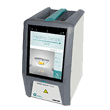Oct-2009
Upgrading residues for high levels of distillate production
A slurry hydrocracking reactor technology demonstrates a high level of conversion of vacuum residues to distillate and gasoline
Dan Gillis, Mark VanWees and Paul Zimmerman
UOP
Viewed : 9989
Article Summary
The shift from gasoline to distillate fuels cannot be accomplished solely by modifi-cations to current hydrocracking or FCC operations. New technologies will be required that achieve higher conversion and increased selectivity to distillate-range products. Ideally, these technologies should be both cost-effective and commercially proven.
To this end, UOP has developed the Uniflex Process, a high-conversion slurry hydrocracking technology that contains elements of a commercially proven slurry reaction system and the Unicracking and Unionfining technologies. The Uniflex Process can achieve non-distillable conversion levels in excess of 90 wt%, with a distillate yield of over 50 vol%. This article discusses the features of the technology, its yield and economic advantages over conventional residue upgrading technologies, and other applications of the technology.
Residue conversion technologies
Conventional residue conversion solutions are well developed and, mostly, operate efficiently within their technical constraints. Figure 1 shows the worldwide distribution of the major residue conversion technologies that refiners have installed. Thermal technologies such as visbreaking and coking account for approximately two-thirds of this installed capacity, with hydroprocessing, residue fluid catalytic cracking (RFCC) and solvent deasphalting, to a lesser extent, making up the remainder.
Visbreaking and delayed coking
Visbreaking is the oldest of all residue upgrading technologies. The large number of installed visbreakers reflects refiners’ needs to minimise residue fuel oil cutter stocks. Few new visbreaking projects are being considered, primarily because a visbreaker’s major product is residue fuel oil, for which demand is not increasing.
A significant number of recent projects have selected delayed coking due to the technology’s ability to fully convert non-distillables. The product yields, consisting of light ends, naphtha, distillates, heavy coker gas oil (HCGO) and byproduct coke depend on the feedstock’s qualities. The HCGO product is suitable as feedstock for downstream hydro-processing, hydrocracking and FCCUs. For these reasons, the majority of recent grassroots and major refinery expansion projects have selected a combination of delayed coking and hydrocracking to maximise distillate yields. While delayed coking tech-nology continues to be improved from the perspectives of operations and reliability, only minor improvements in reduced coke yield and increased liquid yields have been obtained.
Residue hydroprocessing
Hydroprocessing, including fixed-bed residue hydrotreating and ebullated-bed residue hydrocracking, has had limited commercial application. Typically, fixed-bed residue hydro-treating processes, such as the UOP RCD Unionfining Process, are used in conjunction with RFCC-type units to address gasoline-focused markets. This is due to the hydrotreating unit’s ability to obtain very high levels of removal of residue contaminant and reduction of Conradson carbon (CCR).
Ebullated-bed residue hydrocracking can obtain conversion levels equivalent to, or even higher than, delayed coking. However, it produces a low- to medium-quality liquid residue product that is usually only suitable for fuel oil applications.
Solvent deasphalting
As with residue hydrotreating, applications of solvent deasphalting (SDA) have been limited. Recently, however, interest in the combination of SDA and conversion technologies to obtain higher vacuum residue conversion has increased. SDA applications are typically limited by the ability of the downstream conversion unit to process the recovered deasphalted oil, and by limited uses for its large volume of pitch byproduct.
Slurry hydrocracking alternative
The need for high conversion and high distillate yields requires the development of more selective processes for vacuum residue conversion, as illustrated by the price differential trends shown in Figure 2.
Following an evaluation of alternative residue conversion technologies, it was concluded that slurry hydrocracking technology has the highest potential to meet these requirements. Although not well known to most refiners, slurry hydrocracking is actually one of the industry’s oldest residue conversion technologies. It involves the processing of a mixture of residue and fine particulate catalyst in an upflow reactor in a hydrogen-rich environ-ment. This reaction environment facilitates very high conversion of residue to liquid products, particularly distillate boiling-range components.
The first slurry processes were developed in the 1920s and 1930s, to liquefy coal to produce low-quality distillates. These first processes utilised extremely high pressures and were hampered by high costs and operational issues. Eventually, slurry hydrocracking was recognised as a potential solution for the conversion of difficult vacuum residues to transportation fuels. The strong presence of processes such as delayed coking and residue hydrotreating, however, limited its application. It was not until the development of heavy and extra-heavy crude oil projects in the late 1970s and early 1980s that interest in slurry hydrocracking re-emerged. However, the collapse of heavy-to-light crude price differentials in the late 1980s severely curtailed the need for a high conversion technology such as slurry hydrocracking.
In the early years of the current decade, the evaluation of several options focused on providing a commercially viable slurry hydro-cracking technology. It was decided that the most efficient approach involved Natural Resources Canada’s (NRCan) CANMET hydrocracking process.
In 2006, UOP began work with NRCan to evaluate and improve the CANMET hydrocracking process technology. Pilot plant testing was conducted, as well as detailed reviews of engineering design and operations. UOP acquired the exclusive worldwide rights to license the CANMET hydrocracking process in 2007. Continuing work has resulted in the development of the Uniflex Process, which includes a combination of elements from the CANMET hydrocracking process’s reactor section and from UOP’s Unicracking and Unionfining process technologies.
Sponsor:
Categories:
Add your rating:
Current Rating: 4
















